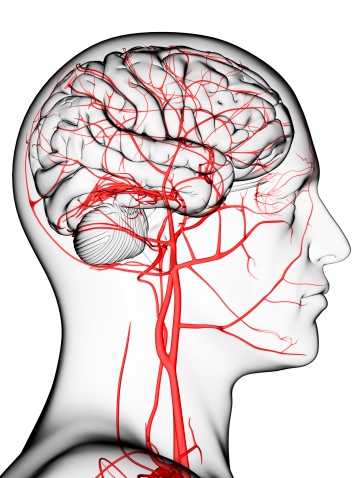WHAT IS CEREBROVASCULAR ACCIDENT(STROKE)
Cerebrovascular
accident (CVA) also known as Stroke or Apoplexy is a condition that produces
sudden neurological signs and symptoms and paralysis as a result of rapture of
a cerebral blood vessel or occlusion by a blood clot leading to disruption of
blood supply to the brain tissue and death of brain cells.
INCIDENCE
It
is considered often as disease of the aged because approximately 60-75% of all
CVA cases occur in persons over 65 years of age. Young people occasionally
sustain CVA because of trauma to cerebral blood vessels, inflammatory disorders
of arteries of the brain, or congenital vascular anomalies. CVA is a major
public health problem in terms of mortality and permanent disability. In United
States, it is ranked third among all causes of death.
TYPES
OF STROKE
A. EMBOLIC:
It has sudden onset and sometimes can be transient
B. THROMBOLIC:
It has gradual onset. It is the most common cause and is usually due to
atherosclerosis.
2. HAEMORRHAGIC STROKE:
It has a sudden onset. It occurs from ruptured secular aneurysm or as a result
of ruptured cerebral blood vessel secondary to hypertension or subarachnoid haemorrhage.
SPECIFIC CAUSES OF STROKE
1. CEREBRAL HAEMORRHAGE:
Rupture of the blood vessel that produces haemorrhage into the brain tissue. It
is common in cases of hypertension.
2. CEREBRAL THROMBOSIS: It
is most common cause of stroke. The cerebral arteries are affected by
arteriosclerosis; in which the lumen of the arteries becomes thickened and
rough. The flow of blood is obstructed and clotting occurs. This clot blocks
the artery and deprives part of the brain of its blood supply.
3. CEREBRAL EMBOLISM:
An embolic or detach clot may lodge in one of the cerebral arteries to cause
obstruction and once there is obstruction, there will be no blood flow and
brain cells die.
PREDISPOSING (RISK) FACTORS OF STROKE
1. Hypertension
2. Diabetes
Mellitus
3. Heart
Disease
4. Cigarette
Smoking
5. Excessive
Alcohol Intake
6. Obesity
7. Family
History of Stroke
8. Ageing
9. Emotional
Stress
10. Polycythaemia
11. Use
of Oral Contraceptive
PATHOPHYSIOLOGY OF STROKE
When the blood vessel
supplying an area of the brain is blocked by an embolus, thrombus, or ruptures,
ischaemia of brain tissue occurs. This leads to hypoxia, anoxia, and
hypoglycaemia. The affected
part of the brain produces neurological dysfunction and paralysis. If ischaemia
persists, necrosis of the deprived area follows. The infarcted area eventually
liquefies and is absorbed and neurological defects remain. Since the cerebral hemisphere controls the
contra lateral side of the body, damage to the left hemisphere produces
paralysis in the right side of the body and vice versa.
CLINICAL FEATURES
1. Dysphasia
2. Paraesthesia
3. Diplopia
4. Blurred
vision
5. Dizziness
6. Visual
field cut
7. Hostility
8. Forgetfulness
9. Difficulty
in comprehension
10. Anxiety
11. Depression
DIAGNOSTIC INVESTIGATIONS
1. Lumbar
puncture reveals bloody cerebrospinal fluid in haemorrhagic stroke.
2. Computed
tomography scan of the brain shows ischaemic areas of the brain or reveals
evidence of haemorrhage or isolate structural abnormalities.
3. Magnetic
Resonance Imaging helps to identify lesion occupying areas.
4. Angiography
outlines blood vessels and pinpoints occlusion or ruptured sites.
5. Electroencephalogram
may show low-voltage, slow waves in ischaemic infarction. If haemorrhage, it
may show high-voltage but slow waves.
Other investigations may include urinalysis, coagulation studies, complete blood count, and serum osmolarity, and electrolyte, Creatinine and urea nitrogen level
MEDICAL
TREATMENT
Medical treatment
includes dietary management, physical rehabilitation, and drug regimen to help
reduce risk factors. Drugs useful in stroke include;
1. Antihypertensive
example Nefidipine to reduce hypertension
2. Analgesics
example Paracetamol to control headache
3. Anticoagulant
example Heparin to prevent further development of thrombosis and embolism.
4. Antiplatelet
example Aspirin to prevent clotting and reduce risk of recurrent stroke after
treatment has begun.
5. Corticosteroids
example Dexamethasone to minimise associated cerebral oedema.
6. Anticonvulsants
example Phenytoin to treat seizures.
7. Stool softeners example Sulfocuccinate to
avoid straining which increases intracranial pressure.
8. Haematinics
example Folic Acid to help in red blood cell formation to reverse the effect of
antibiotic therapy in decreasing red blood cell production.
9. Antibiotic
example Capsule Amoxicillin to prevent risk of infection.
10. Mild sedatives example diazepam to help reduce restlessness.
SPECIFIC SURGICAL TREATMENT
One of the following
surgical procedures can be carried out depending on the cause of stroke
Ø Craniotomy
to help reduce haematoma.
Ø Endoarterectomy
to help remove arteriosclerosis plaques from inner arterial wall
Ø Intracranial
bypass to circumvent an artery that is blocked or ventricular shunt may be done
to drain cerebrospinal fluid.
COMPLICATIONS
1. Paralysis
2. Seizures
3. Hypostatic
pneumonia
4. Contractures
5. Neuropathy
PREVENTION
1.
Avoid smoking and alcohol intake.
2.
Ensure regular check ups especially the
blood pressure and weight.
3.
Avoid or minimize stress.
4.
Ensure regular exercise.
5.
Control weight by reducing fat intake.
6.
Avoid excessive intake of oral
contraceptive.
7.
Reduce intake of sodium and cholesterol
diet.




Comments
Post a Comment